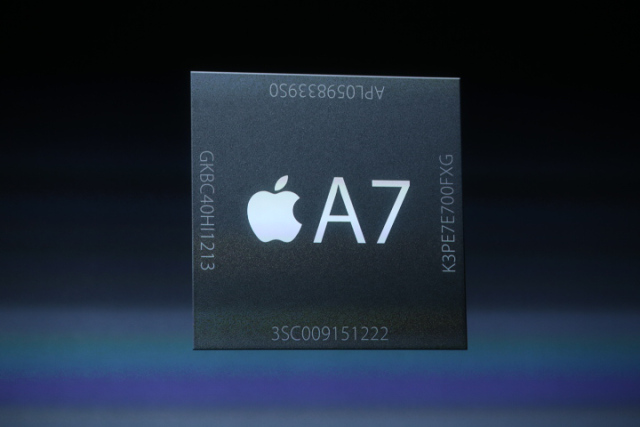 The disappointment amongst analysts is palpable. Dreams of low cost iphones for the masses were kicked away when Apple introduced their two new iphones at the same price points as the old ones. Clearly Apple is playing a different game than what most others are anticipating as the market runs to 5BU. The market has split into the land of free Android hardware and software (80% of the market) and that of the 20% profitable niche that has led Microsoft to buy Nokia in order to save the “burning platform.” The truth is every platform is on fire as the big ecosystem players try to profitably leap frog to where the dollars are. Tim Cook has never explicitly said so, but his goal is not to offer cheap iphones to the masses, rather it is to conquer the Corporate Wintel Empire in as short a period of time as possible. The refreshed iphones will support his efforts, however it is possible that A7 powered iPADs will be a more significant contributor.
The disappointment amongst analysts is palpable. Dreams of low cost iphones for the masses were kicked away when Apple introduced their two new iphones at the same price points as the old ones. Clearly Apple is playing a different game than what most others are anticipating as the market runs to 5BU. The market has split into the land of free Android hardware and software (80% of the market) and that of the 20% profitable niche that has led Microsoft to buy Nokia in order to save the “burning platform.” The truth is every platform is on fire as the big ecosystem players try to profitably leap frog to where the dollars are. Tim Cook has never explicitly said so, but his goal is not to offer cheap iphones to the masses, rather it is to conquer the Corporate Wintel Empire in as short a period of time as possible. The refreshed iphones will support his efforts, however it is possible that A7 powered iPADs will be a more significant contributor.
Microsoft’s acquisition of Nokia’s phone business is an affirmation that in the end software must reside on a physical device and at the reach of every finger-tip. Microsoft and Intel had 30 years to refine, improve and cost reduce the PC thereby displacing all but the fewest of mainframes. They were even able to execute a mid life kicker with mobile PCs. However, in the end, cellular changed the formfactor requirements thus sending PCs to the legacy farm. The folks in Redmond see where the thread of a reduced corporate compute footprint combined with lack of control of today’s mobile leads. And yet, with as profitable Office is, they refuse to port to iOS because the hardware guys are now in control.
Apple’s introduction of the 64-bit A7 CPU with a “desktop class architecture” and over 1Billion transistors and 2X performance is messaging straight out of the Intel PR handbook. The bar has been raised and they will now start the corporate spec-manship game against their rivals. Add in the security message of iOS and we have the transmorphing of the messages that Wintel used to sell the corporate world to those that Apple will use.
Beyond the messaging, one has to think of the impact a 64 bit A7 will have across an entire platform of products. While the new CPU is at this stage overkill for the iphone, it is certainly interesting in what it could bring to the iPAD or an ARM based Mac Air. On the roadmap must surely be a multitasking iOS that requires increased CPU horsepower and the ability to address more than 4GB of memory. Apple has entered x86 Silvermont territory.
The cannibalization of the 9.7” iPAD by the iPAD mini this past year shows not only are there multiple tablet market segments but that a sustainable high end market requires more than just a larger screen. The consumer would rather surf the internet with a smaller, lighter tablet and skip the keyboard. Apple has been slow to upgrade the larger iPAD into something meaningful and perhaps it is all because they were waiting on the A7 to power a mobile that can truly offer “Office functionality.” Look for VmWare and Parallels as well as iwork to be leveraged to offload Microsoft wherever possible. As for the A7, the 102mm die size is quite interesting as it is around the same point where Intel in the 1990s would build their low end CPU targeting corporate. It is obviously an economic, wafer yielding inflection point.
It is safe to say at this point that no one in the PC or mobile industry can accurately predict the true size of the PC and tablet markets given the turnover of new products, the absorption of new technology and the inability of buyers to fully understand the productivity tradeoffs. Experimentatin leads the way which means Apple, Microsoft, Google and the rest of the players will be introducing even more products at every smaller price point divergences in order to stay close to changes in trends.
History says that consolidation follows.
With its expensive iphone 5C and 5S swimming in a sea of <$100 smartphones, Apple seems to be drawing a line in the sand in the consumer space while it builds its moat around corporate. The winner of corporate though has to win the $500-$999 mobile space and that is up for grabs. The mobile has to be very light, outfitted with a 10-11” screen and keyboard and last all day on a charge. Apple has it in the MAC Air, but it is $999 and above. The PC players are rushing in with Windows and Android tablets. Depending on what Apple introduces in the next couple months will determine if they see a return to growth in this segment or if the battle ends up raging for years.
Share this post via:









Quantum Computing Technologies and Challenges